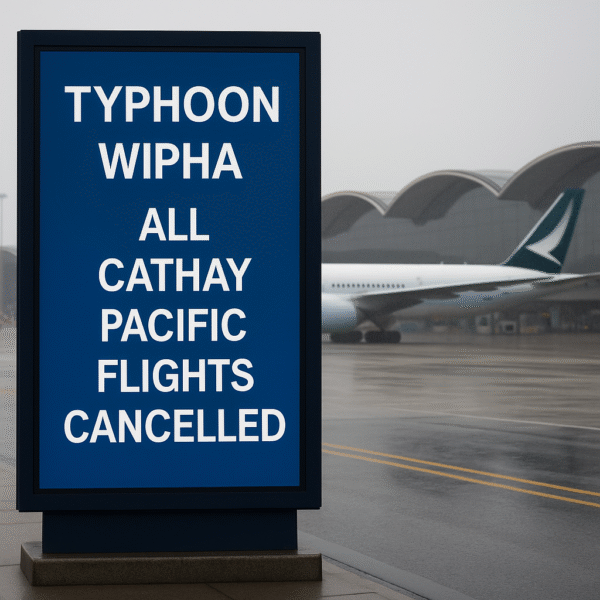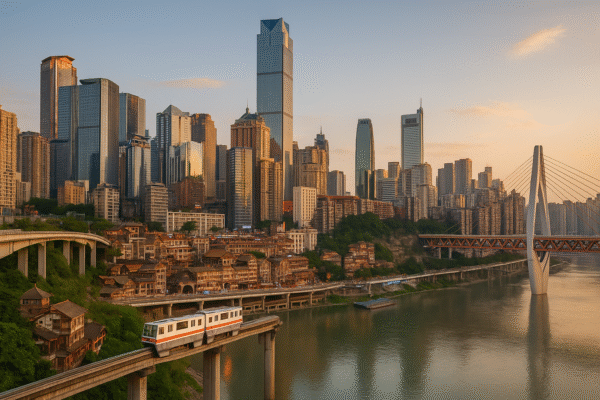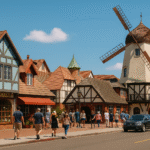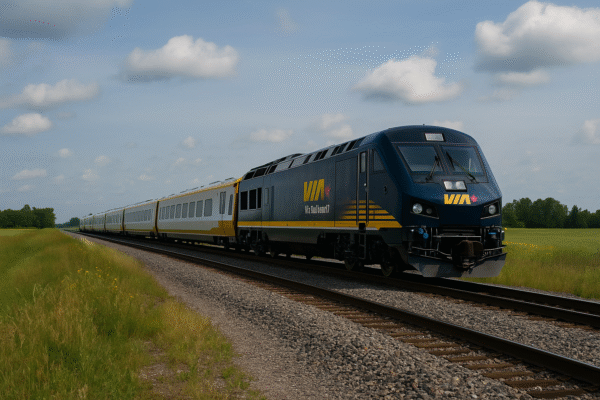Tucked away in China’s mountainous southwest, Chongqing is a megacity that defies the imagination—both in size and design. With a population nearing 18.2 million, it is one of the largest municipalities in China, yet it remains relatively unknown to most international travelers. A city of towering verticality, dramatic river confluences, gravity-defying architecture, and some of the most legendary food in China, Chongqing is no longer just a local powerhouse—it’s a rising global travel destination.
A Vertical Urban Jungle Carved Into Mountains
Unlike other Chinese metropolises built on flat plains or coastal areas, Chongqing rises from steep hills and plunging valleys, where the Yangtze and Jialing rivers converge. Its mountainous terrain gives the city a unique, multi-level geometry. Roads, railways, bridges, and even skyscrapers are often suspended above the landscape, clinging to cliffs or diving into the earth through tunnels.
This topographic drama has driven some of the most innovative urban planning in the world. Entire neighborhoods are stacked vertically. Monorails weave through residential towers, and walkways seem to defy gravity. This natural-meets-futuristic landscape has earned Chongqing nicknames like the “8D Magic City” and the “Mountain City.”
Sci-Fi Skylines: A Glimpse Into Tomorrow
Among the city’s most striking futuristic features is Raffles City Chongqing, a multi-use megastructure located at the tip of the Yuzhong Peninsula. Designed by world-renowned architect Moshe Safdie, the complex includes a skybridge—the “Crystal”—suspended across four skyscrapers and resembling a horizontal skyscraper in itself. It’s a surreal sight that cements Chongqing’s place among the world’s most architecturally adventurous cities.
Just nearby, you’ll find Hongyadong, a visually arresting 11-story cliffside complex that looks straight out of a Studio Ghibli movie. Lit by thousands of lanterns at night and brimming with traditional wooden architecture, it perfectly contrasts the glass-and-steel skyline just above it.
These architectural juxtapositions—old meets new, vertical meets natural—make Chongqing one of the most visually compelling urban experiences on Earth.
A City That Moves Differently: Monorails and Cable Cars
Chongqing’s urban mobility is another testament to its geographic defiance. The city’s Chongqing Rail Transit (CRT) is the busiest monorail network in the world and possibly the most photogenic. The monorail famously passes directly through a 19-story apartment complex in the Liziba district—an internet sensation that encapsulates the city’s flair for the surreal.
Cable cars ferry commuters and tourists across rivers, while inclined elevators climb the hillsides. Visitors can even ride a river cable car above the Yangtze, offering unmatched views of Chongqing’s illuminated skyline.
These innovations make navigating the city fun and efficient despite its steep terrain—and give visitors the sensation of traveling through a sci-fi film.
Chongqing’s Fiery Cuisine: A Hotpot Haven
No visit to Chongqing is complete without sampling its legendary hotpot. Unlike the mild versions found elsewhere, Chongqing hotpot is a fiery cauldron of chili oil, Sichuan peppercorns, and bold spices. Diners dip meats, tofu, and vegetables into bubbling broth, experiencing the addictive málà (numbing-spicy) sensation that defines Sichuan cuisine.
In addition to hotpot, don’t miss Chongqing noodles (xiǎomiàn)—a street-food staple known for its rich, spicy broth—and dry-fried dishes that reflect the region’s bold culinary identity. Many recipes highlight fresh catches from the Yangtze River and use local herbs grown in the region’s fertile hills.
Time Travel in the Old Quarters
Amid the high-tech spectacle, Chongqing also offers windows into its past. Wander through Ciqikou Ancient Town, a riverside neighborhood lined with Ming- and Qing-dynasty architecture, tea houses, and craft shops. Here, the aroma of sesame cakes and bean curd lingers in the air as locals perform traditional opera or paint calligraphy.
Visit the Great Hall of the People, modeled after Beijing’s Temple of Heaven, or explore the WWII-era caves and bunkers hidden throughout the city, reflecting Chongqing’s role as China’s wartime capital in the 1930s and 40s.
A Nighttime Spectacle on the Yangtze
As the sun sets, Chongqing turns into a dazzling light show. Towering skyscrapers along the riverbanks come alive with digital projections, mirrored by shimmering reflections in the water. Yangtze River night cruises offer a magical way to view the city from a distance, showcasing its unique blend of historic river trade routes and modern innovation.
Why Now is the Time to Visit Chongqing
In recent years, Chongqing has launched tourism campaigns aimed at global travelers looking for something beyond China’s “Big Three” (Beijing, Shanghai, and Guangzhou). It offers all the cosmopolitan energy of a megacity but without the over-tourism of more familiar destinations.
With improved international flight access, the city is becoming more reachable. Initiatives by the China National Tourism Administration and Chongqing Municipal Government have focused on smart tourism, English-language signage, and curated cultural experiences to better serve foreign guests.
Conclusion: The Future Lives Here
Chongqing isn’t just a city—it’s an urban adventure. Whether you’re an architecture enthusiast, a street food lover, or a history buff, Chongqing offers a one-of-a-kind journey through the past and future of China. With its jaw-dropping infrastructure, vibrant food scene, and dramatic natural setting, it’s not just the city you’ve never heard of—it’s the city you’ll never forget.
For more travel news like this, keep reading Global Travel Wire




















